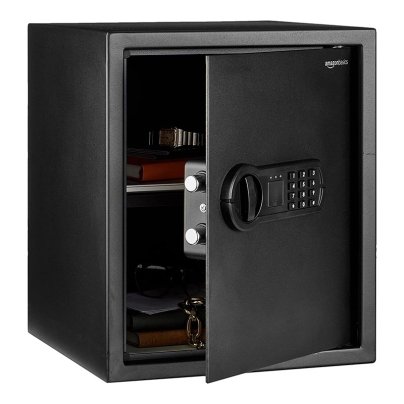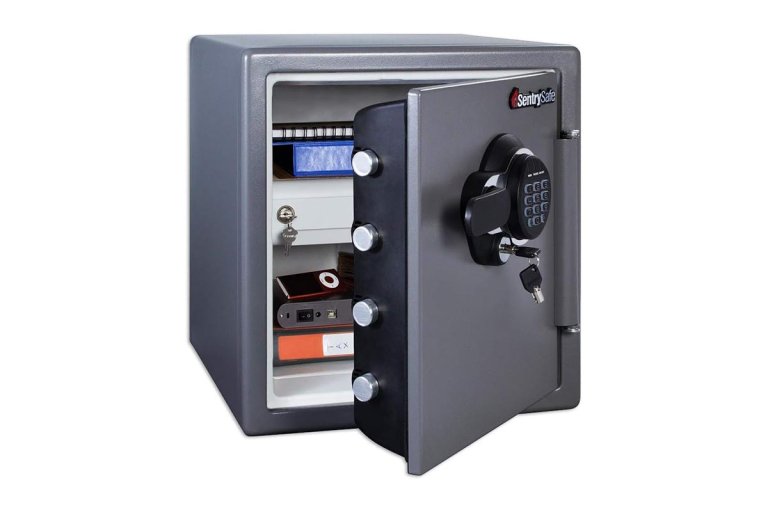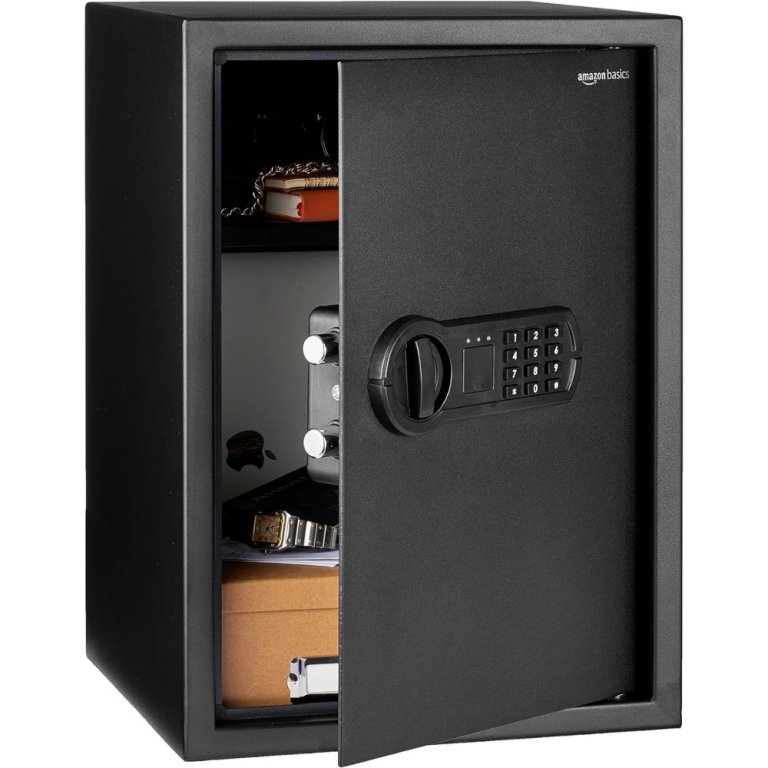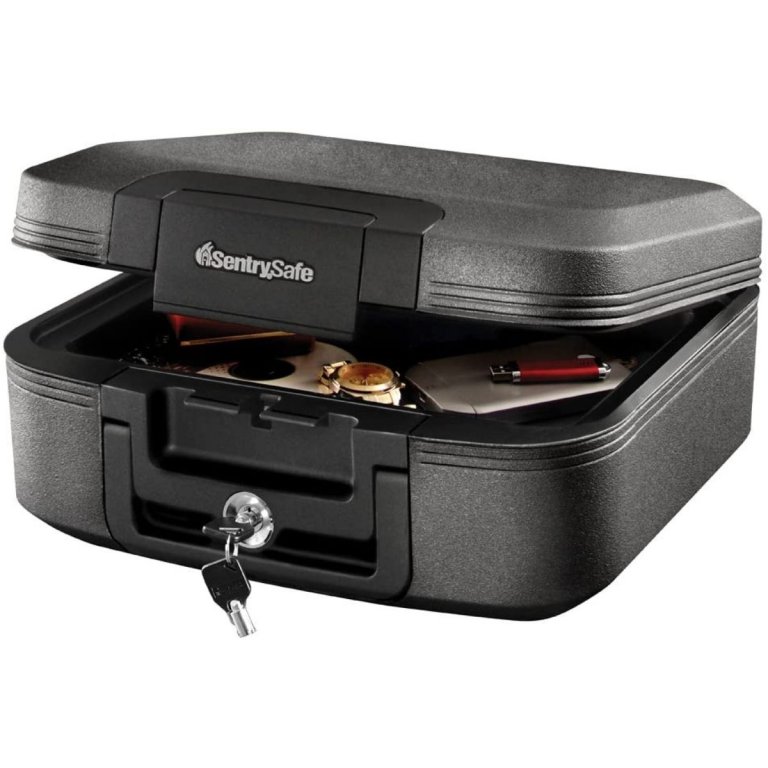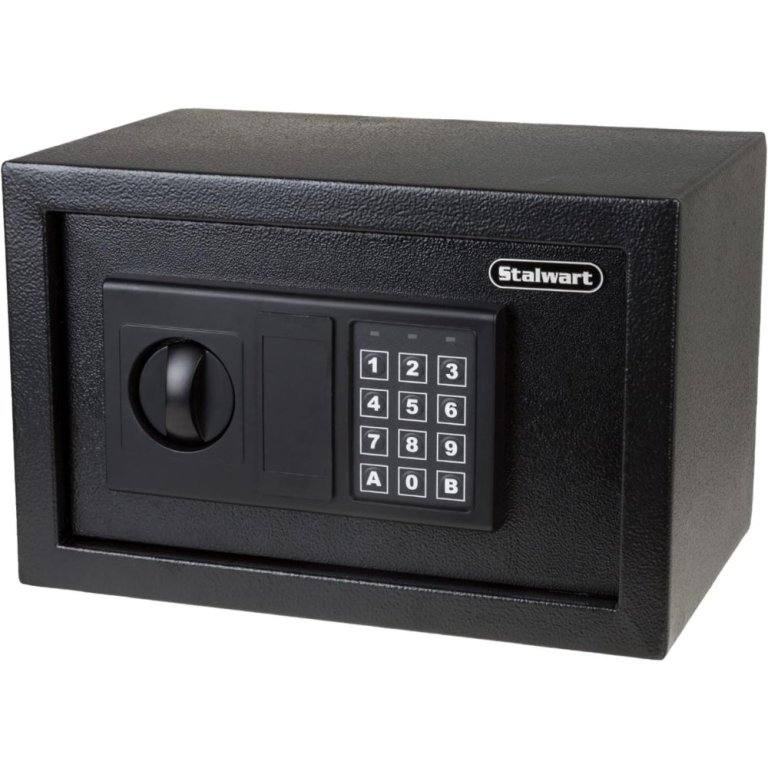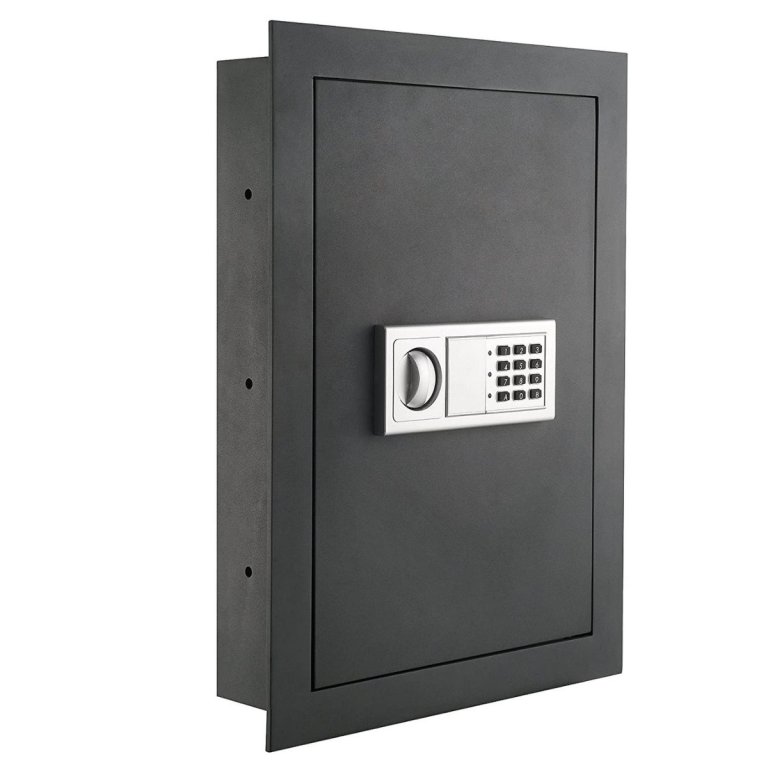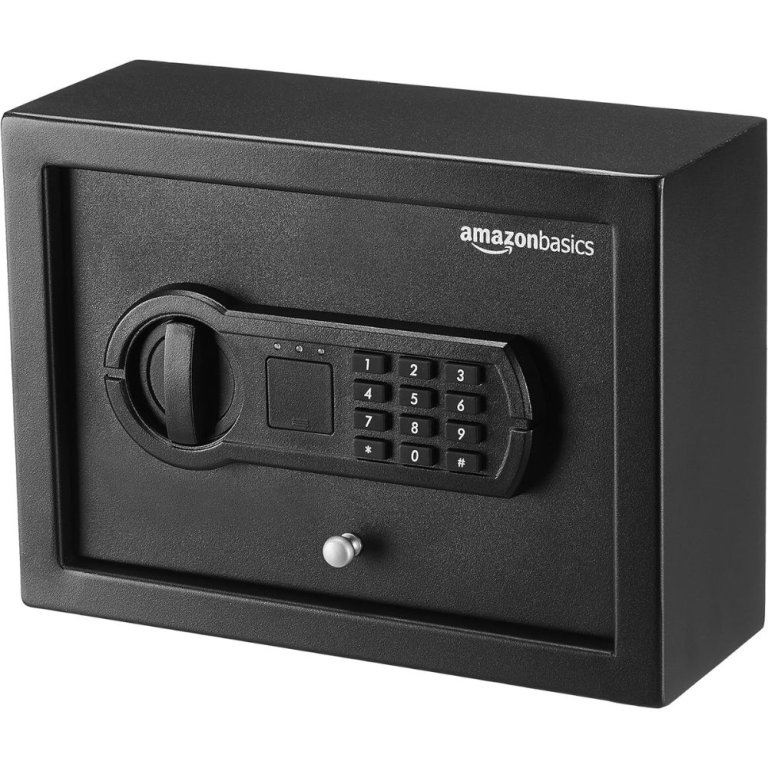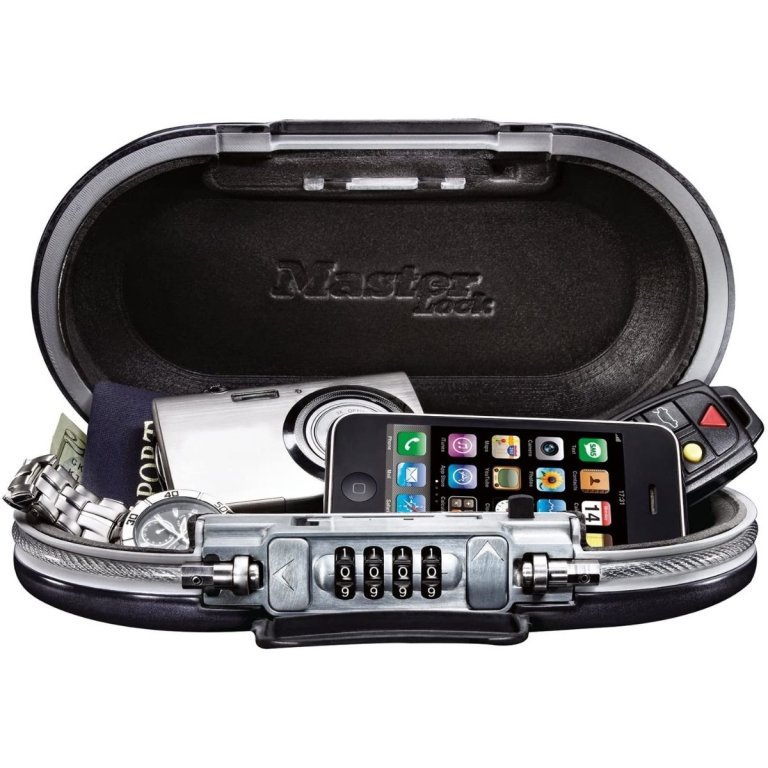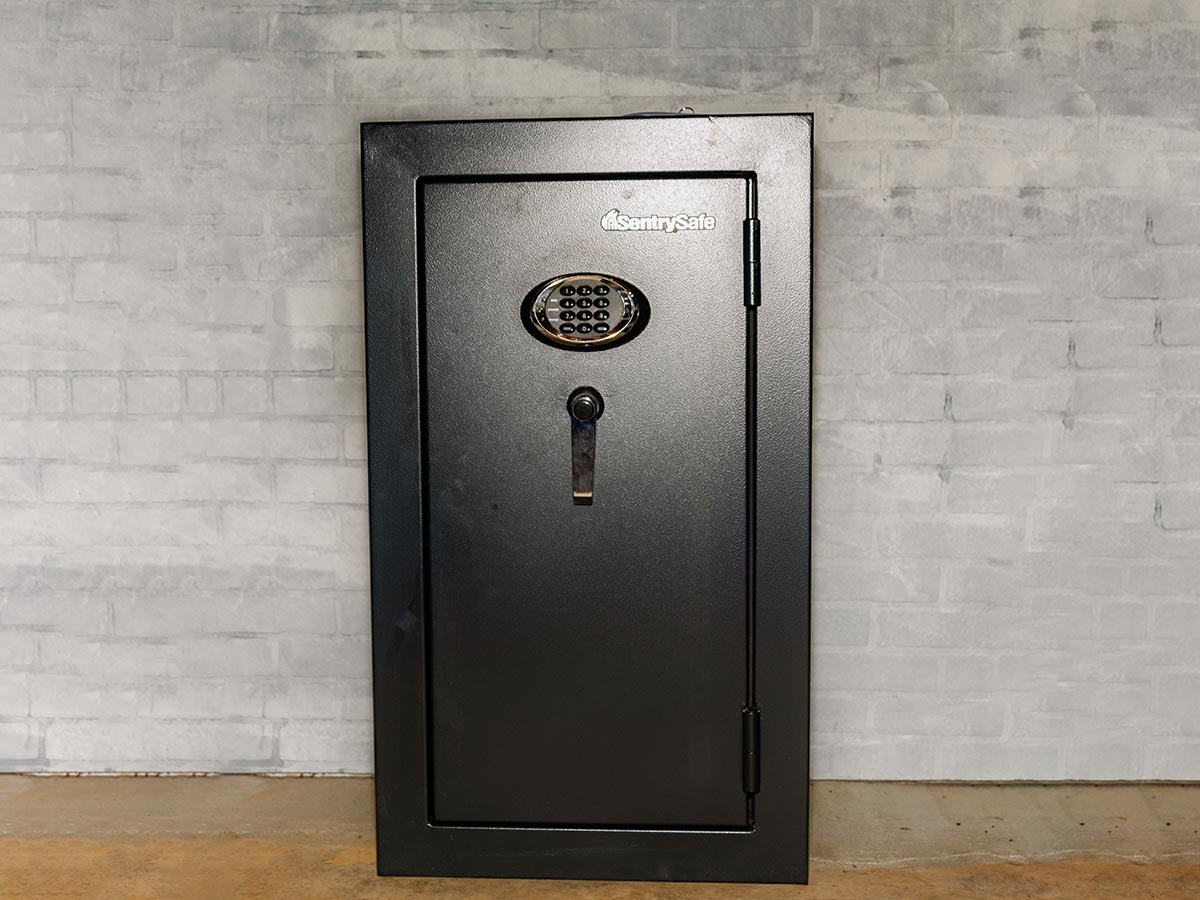
We may earn revenue from the products available on this page and participate in affiliate programs. Learn More ›
Home safes provide peace of mind when you’ve got cash, important documents, jewelry, and other valuables in the house. We recently tested the durability, security, and water resistance of 10 top options to see which protected best. We evaluated basic models that shield against theft as well as higher-end options that offer fire protection and water resistance to keep precious belongings safe during disasters.
Since home safes are meant for some of your most prized possessions, it’s important to look at lock type and protective capabilities when choosing one. Our favorite home safe, the SentrySafe Digital Fire/Water Safe, was best in both these regards. It has great basic features like a digital keypad, backup key, lighted interior, and bolt-down hardware. But what earned it our award for best overall was its ability to withstand fire, heat, and smoke for up to 1 hour and keep contents dry for up to 24 hours in 8 inches of water.
To see which home safe is right for you, consider the items you intend to store and the security the safe offers as well as a host of other features and potential upgrades. Read on to learn the pros and cons of the best home safes and see how each performed in our hands-on tests.
- BEST OVERALL: SentrySafe SFW123GDC Digital Fire/Water Safe
↓ Jump to Review - BEST BANG FOR THE BUCK: Amazon Basics Steel Home Security Electronic Safe
↓ Jump to Review - BEST LOCKBOX: SentrySafe CHW20221 Fire/Water Chest
↓ Jump to Review - BEST DIGITAL: Stalwart Electronic Safe With Digital Keypad and Keys
↓ Jump to Review - BEST WALL SAFE: Paragon Lock & Safe Superior Wall Safe
↓ Jump to Review - BEST MINI: Amazon Basics Small Slim Desk Drawer Security Safe
↓ Jump to Review - BEST LARGE: SentrySafe EF4738E Fire/Water Digital Safe
↓ Jump to Review - BEST PORTABLE: Master Lock Portable Personal Safe
↓ Jump to Review - BEST HIDDEN: Jssmst Book Safe With Combination Lock
↓ Jump to Review
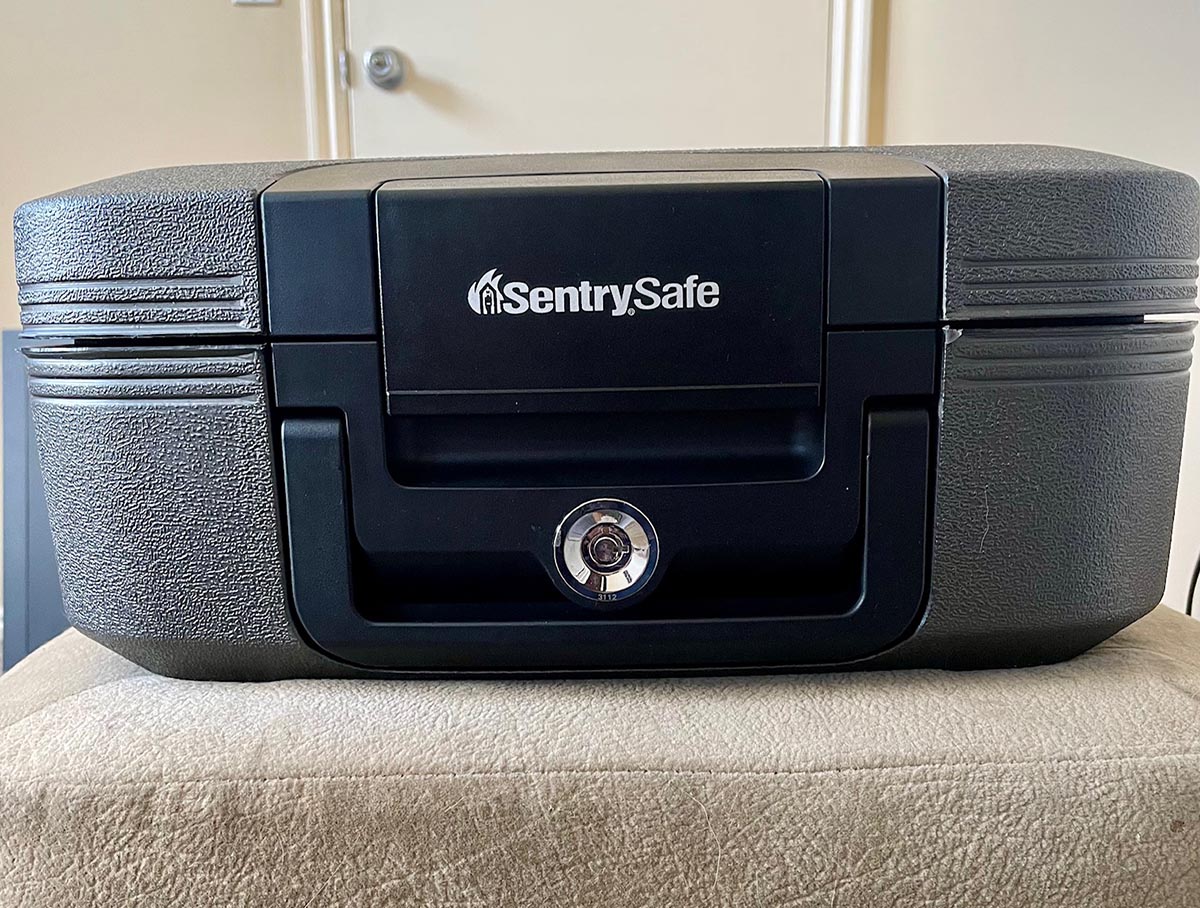
| Testing Stats | |
| Products tested | 10 |
| Time spent testing | 18 hours |
| Tests performed | 5 |
| Price range | $10 to $800 |
Before You Buy a Home Safe
Home safes keep your valuables safe from individual dangers like theft, fire, or water, but not every model safeguards against all of these threats. If you are most concerned about one particular type of threat, consider that as you choose the best safes for home use. Also, look at what you plan to store in your home safe. Different designs work better for specific items, such as a gun safe for storing firearms.
Our Top Picks
Home safes keep their contents safe from perils like theft, fire, and water damage. They provide owners with peace of mind by protecting valuable items, irreplaceable heirlooms, and important documents from such threats. Keep your prized possessions secure in a home safe suited to your needs and preferences.
Best Overall
SentrySafe SFW123GDC Digital Fire/Water Safe
What We Like
- Live-locking bolts plus bolt-down hardware for theft protection
- Includes digital keypad with backup key
- Spacious 1.23-cubic-foot capacity
- Withstands fire for 1 hour
- Withstands 8 inches of water for 24 hours
What We Don’t Like
- Requires 4 AAA batteries, sold separately
Product Specs
- Lock type: Electronic keypad with backup keys
- Exterior dimensions: 17.8 inches high by 16.3 inches wide by 19.3 inches deep
- Weight: 87 pounds
- Material: Steel
Our Ratings: Ease of Use 4.5/5; Water Resistance 4.5/5; Durability 5/5; Security 5/5; Value 4.8/5
Deter theft and enjoy protection from both fire and water with this highly rated and reasonably priced waterproof and fireproof safe. Sturdy steel, four live-locking bolts, a pry-resistant hinge bar, and bolt-down hardware keep valuables and important documents safe and secure.
SentrySafe claims this safe is water-resistant in 8 inches of water for up to 24 hours. We placed a sprinkler on top of ours and let it run for over an hour. When we opened the safe, the toilet paper inside was bone-dry.
Its 1.23 cubic-foot capacity is large enough for stacks of sensitive materials like USB drives, file folders, and jewelry boxes. In addition to protecting from water, it can withstand fire, heat, and smoke for up to 1 hour at 1,700 degrees Fahrenheit. It also has a digital keypad with a backup key, an interior light, and a locking drawer.
Read our full review: SentrySafe SFW123GDC Digital Fire/Water Safe
Get the SentrySafe SFW123GDC home safe at Amazon, Lowe’s, Walmart, or SentrySafe.
Best Bang For The Buck
Amazon Basics Steel Home Security Electronic Safe
What We Like
- 1.52-cubic-foot interior space
- Built-in storage shelf
- Electronic keypad and keyed entry
- 2 live-door bolts and concealed pry-resistant hinges
- Predrilled mounting holes and mounting hardware included
What We Don’t Like
- Not fire- or waterproof
Product Specs
- Lock type: Electronic keypad with backup keys
- Exterior dimensions: 16.5 inches high by 13.8 inches wide by 13 inches deep
- Weight: 33.66 pounds
- Material: 8- and 14-gauge carbon steel
Our Ratings: Ease of Use 5/5;Water Resistance N/A; Durability 3/5; Security 5/5; Value 4/5
Thanks to the included instruction booklet, setting up the Amazon Basics electronic safe was simple, though it did not come with the required four AA batteries for the digital keypad. The interior is just large enough to fit an A4 document without bending or folding it, so you can store important certificates and other files without worry. The safe’s bottom shelf has a felt liner, but there is nothing to soften the removable shelf, so users will want to package delicate items before storing them there.
At over 33 pounds, the Amazon Basics safe is heavy for its dimensions, making it feel quite sturdy, which is a plus for such an affordable model. To test durability, we dropped it onto a concrete surface, and it came out unscathed. Its heavy carbon-steel construction actually chipped the concrete!
One small complaint we had with this safe is the removable panel to access the keyhole, which felt a little flimsy—like it could easily come off and get lost. That aside, the Amazon Basics safe is a well-built, moderately sized model that comes with mounting hardware to bolt it into place. Shoppers should note, however, that this safe is not water-resistant, so a flood would certainly creep into your valuables here.
Get the Amazon Basics steel home safe at Amazon.
Best Lockbox
SentrySafe CHW20221 Fire/Water Chest
What We Like
- Grab-and-go handle for emergencies
- Withstands fire for up to 30 minutes
- Withstands submersion in water for 72 hours
- Elastic straps on interior lid increase organization
What We Don’t Like
- Extra-thick walls limit interior storage
- Not as secure as a home safe that bolts down
Product Specs
- Lock type: Tubular key lock
- Exterior dimensions: 6.6 inches high by 14.3 inches wide by 14.3 inches deep
- Weight: 20.4 pounds
- Material: Captured fire insulation
Our Ratings: Ease of Use 4/5;Water Resistance 5/5; Durability 5/5; Security 4/5; Value 4/5
With interior dimensions of 4.4 inches high by 12.8 inches wide by 8.5 inches deep, this safe for documents, valuables, USB drives, and other small items is built to withstand fire and water. Its simple key-lock design features one main compartment with in-lid organizer straps. It also has a carrying handle that makes it easy to grab in an emergency or as a travel safe.
During testing, we found the tubular key lock a little sticky. While momentarily frustrating, the system actually adds a layer of security by preventing the lid from opening in a fire. The thick walls of this Underwriters Laboratories–rated safe box can withstand 30 minutes of fire at 1,550 degrees Fahrenheit, and its Electrical Testing Laboratories (ETL) verification ensures its waterproof gasket will keep water out for up to 72 hours of submersion. For those with limited space or who want to be able to quickly grab valuables and go, this small lockbox is a great option.
Get the SentrySafe CHW20221 home safe at Amazon or The Home Depot.
Best Digital
Stalwart Electronic Safe With Digital Keypad and Keys
What We Like
- Portable but reasonably sized safe
- Sturdy steel construction
- Comes with 2 backup keys
- Can be bolted to the wall or floor
What We Don’t Like
- Not fire- or water-resistant
- User code is erased when shut off
Product Specs
- Lock type: Electronic keypad with backup keys
- Exterior dimensions: 7.9 inches high by 12.2 inches wide by 7.9 inches deep
- Weight: 9.25 pounds
- Material: Steel
Our Ratings: Ease of Use 4/5;Water Resistance N/A; Durability 4/5; Security 3/5; Value 4/5
Looking to hide small holiday gifts from snooping kids? Want a spot for jewelry and other valuables while repair people are in your house? This Stalwart safe with electronic lock might work well for you. At about a foot wide and 8 inches high by 8 inches deep, it’s roughly the size of a bread box—room enough for passports, jewelry boxes, or folded papers. Its steel construction feels fairly durable, and it comes with bolts (and drilled holes in the sides of the safe) for affixing it to the wall or floor. At just over 9 pounds, it’s heavy enough that you won’t want to schlep it while traveling but not so heavy that a burglar couldn’t simply steal it rather than attempt to crack it.
During testing, we were happy to see we couldn’t access the safe’s interior reset button by poking a stick through the bolt holes in the back and bottom of the unit. If you or a would-be thief enter an incorrect code three times, its automatic keypad-disabling function activates a warning beep that only stops by removing one of the batteries. Just be aware that powering it down erases the user code, making the safe key your only option until it’s reset.
Bottom line? This is a decent unit for the back of your closet or the top of your dresser—but for heaven’s sake, don’t lose the keys.
Get the Stalwart home safe at Amazon.
Best Wall Safe
Paragon Lock & Safe Superior Wall Safe
What We Like
- Made of heavy steel
- Sized to fit between wall studs
- Easy-to-follow instructions
- Includes mounting hardware and batteries
- Access panel sticks out just 0.5 inch from surface
- 5-minute auto alarm sounds after 3 incorrect codes are entered
What We Don’t Like
- Locking mechanism is large
- Not fire- or water-resistant
Product Specs
- Lock type: Electronic keypad with backup keys
- Exterior dimensions: 22 inches high by 16 inches wide by 4 inches deep
- Weight: 39 pounds
- Material: Steel
Our Ratings: Ease of Use 5/5;Water Resistance N/A; Durability 5/5; Security 5/5; Value 4.5/5
With a virtually flat profile, a wall safe is a great way to hide valuables behind artwork or furniture. Though it requires some tools and a little effort to install, this option from Paragon Lock & Safe comes with the necessary mounting hardware and is sized right to fit between studs. Just be sure you insert the included batteries and set up your user and manager codes first. This process is much easier when the safe is still on the ground.
Also, be aware that, like many safes, the Paragon safe is shallow, measuring just 4 inches deep. It has three interior shelves, but the housing of the locking mechanism takes up most of the middle shelf. Still, the other two shelves provide ample space for cash, jewelry, folded documents, and small heirlooms. While this wall safe is not fire- or water-resistant, it does include an extra theft-busting feature: an automatic 5-minute alarm that sounds after three incorrect code entries, alerting everyone nearby of the failed entry.
Get the Paragon home safe at Amazon.
Best Mini
Amazon Basics Small Slim Desk Drawer Security Safe
What We Like
- Small safe that’s great for travel
- Constructed of heavy-duty steel
- Can be mounted to a desk or wall
- Pry-resistant design features 2 secure door bolts
What We Don’t Like
- Keypad batteries dislodge relatively easily if dropped
- Interior space is cut in half by battery housing
Product Specs
- Lock type: Electronic keypad with backup keys
- Exterior dimensions: 4.4 inches high by 11.8 inches wide by 8.6 inches deep
- Weight: 10.34 pounds
- Material: Steel
Our Ratings: Ease of Use 5/5;Water Resistance N/A; Durability 5/5; Security 4/5; Value 4.8/5
Measuring 4.4 inches high by 11.8 inches wide by 8.6 inches deep, this mini safe is slim enough to fit inside a standard desk drawer. It features heavy-duty alloy steel construction and unlocks via a convenient electronic keypad or backup keys. One word of caution on this particular option, however: Be careful as you move it around. During testing, we found that even drops of around a foot sometimes dislodged the batteries enough to disrupt the keypad’s functionality. Also, like many electronic keypads, the batteries’ housing takes up a portion of the internal space. For this small safe, that means about half the interior area is unusable.
If you’re looking to store passports, folded papers, or small jewelry boxes, however, rest assured they’ll be protected by two secure door bolts and pry-resistant, concealed hinges. At just over 10 pounds, you could use this mini safe as a portable option for travel or employ the included mounting hardware to install it in a drawer, closet, or other hidden space.
Get the Amazon Basics desk drawer home safe at Amazon.
Best Large
SentrySafe EF4738E Fire/Water Digital Safe
What We Like
- ETL verified half hour fireproof up to 1,400 degrees Fahrenheit
- ETL verified 72 hours waterproof up to 12 inches
- Secures via customizable key codes, 5 live locking bolts, and 4 deadbolts
- California Department of Justice–certified gun safe
What We Don’t Like
- May not have adequate level of protection for paper in fire
- Not designed to be waterproof when submerged
Product Specs
- Lock type: Electronic keypad with backup keys
- Exterior dimensions: 37.7 inches high by 27.7 inches wide by 19 inches deep
- Weight: 217 pounds
- Material: Steel
Our Ratings: Ease of Use 5/5;Water Resistance 4/5; Durability 4/5; Security 5/5; Value 5/5
During testing, positioning the big 217-pound SentrySafe EF4738E safe was the most difficult part. Once in place, the installation hardware, keypad, locking mechanism, and setup instructions worked as smoothly as we wanted. Also, the digital keypad allowed us to create and erase as many custom access codes as we needed.
From a security standpoint, this safe excelled. Its five live locking bolts and four deadbolts created a superstrong barrier to unauthorized access, leaving us unable to crack the safe with any of the well-known internet hacks we tried. As a large home safe, its roomy 4.71 cubic feet of interior space and three carpeted shelves make it a great option for home storage of larger valuables.
Though described as a fire- and waterproof safe, it offers only modest protection from these elements. It passed our overhead sprinkler and 12-inch flooding tests with no detectable moisture infiltration, but the door seal is not designed to protect against submersion. Likewise, it offers just a half hour of fire protection at 1,400 degrees Fahrenheit. If a fire reaches hotter temperatures or burns longer than a half hour, any papers or cash inside the safe could combust.
Get the SentrySafe EF4738E home safe at Amazon, Lowe’s, or The Home Depot.
Best Portable
Master Lock Portable Personal Safe
What We Like
- Lightweight for carry-on luggage or day trips
- Sized right for passport, phone, slim wallet, and cash
- Braided cable is useful for anchoring
What We Don’t Like
- Too small for large personal items or valuables
- Splash-proof, but heavy rain can get in
Product Specs
- Lock type: Combination lock
- Exterior dimensions: 2.25 inches high by 9.53 inches wide by 4.92 inches deep
- Weight: 1.3 pounds
- Material: Molded plastic
Our Ratings: Ease of Use 5/5;Water Resistance 1/5; Durability 4/5; Security 4/5; Value 4/5
Master Lock’s clamshell-style personal safe is designed to neatly fit and guard a smaller set of valuables, such as a slim wallet, cash, or jewelry. We tested it on an overseas trip for passports and keys, but it will also fit travel items like a GoPro or digital camera. Since it weighs just over a pound, this portable safe was hardly noticeable in our carry-on bag.
While Master Lock markets this safe as water-resistant, it filled with water when we left it in a shower to simulate a storm, so we don’t recommend leaving it outdoors on a camping trip. Otherwise, the hard plastic was durable enough to survive our smash tests but could probably be cut open with the right tools. And though it’s small, it’s not easy to walk off with when you wrap the braided cable around a stationary object.
Several years back, a lock picker posted a YouTube video of how he opened this version in minutes without tools by simply spotting the gates in the combination locking mechanism. We tried replicating his trick without luck, so it looks like Master Lock has improved the design. Even so, we locked it down in a hidden spot or kept it somewhere we had an eye on it during a day trip.
Get the Master Lock home safe at Amazon, Ace Hardware, The Home Depot, Walmart, or Master Lock.
Best Hidden
Jssmst Book Safe With Combination Lock
What We Like
- Blends in on a bookshelf
- Lightweight metal construction is easy to move
- Good for hiding jewelry and passports
What We Don’t Like
- Not as secure as more robust home safes
- Narrow inside
Product Specs
- Lock type: Combination lock
- Exterior dimensions: 9.5 inches high by 6.2 inches wide by 2.2 inches deep
- Weight: 1.65 pounds
- Material: Metal
Our Ratings: Ease of Use 5/5; Water Resistance N/A; Durability 4/5; Security 2/5; Value 3.5/5
The Jssmst book safe is a small concealment safe that comes with a combination lock inside a dictionary facade. The safe is meant to tuck small valuables out of sight at home or in the office. In our tests, we found this safe extremely convenient to use and store as well as excellent for concealment, but lacking in actual security.
Setting up the safe was straightforward: Set the code, put valuables inside, lock the safe, and place it on a shelf. In its “stealth” mode, the safe looks like a real book, particularly when sitting on a shelf with other hardcover books.
However, for actual security, a lot remains to be desired. We found the safe to be obvious when actually picking up and handling it, meaning it won’t fool any would-be thieves if they get their hands on it. More importantly, we broke through the lock by trying every possible combination in just under 20 minutes. The safe is likely also not strong enough to survive a more forceful entry using tools.
Get the Jssmst home safe at Amazon.
Jump to Our Top Picks
How We Tested the Best Home Safes
When choosing which home safes to test, we considered basic features like build, wall thickness, and locking mechanisms. We looked at safes of various sizes, weights, and intended purposes, such as travel or concealment. We included options rated for fire resistance and water resistance since they provide an added layer of protection in the event of a natural disaster. We also looked for models with extra features like protective carpet, lighting, and adjustable shelves.
Once we had our safes, a team of Bob Vila writers and editors across the country each performed a series of tests. We used common safe-cracking methods to check basic security and repeatedly dropped the safes against hard surfaces to measure durability. For safes claiming water resistance, we put them in a shower for at least 15 minutes with a roll of toilet paper inside. If waterproof, we submerged the safes storing TP in a bathtub full of water for a minimum of an hour. If the toilet paper showed even the slightest hint of moisture in either test, the safe lost points on our rubric.
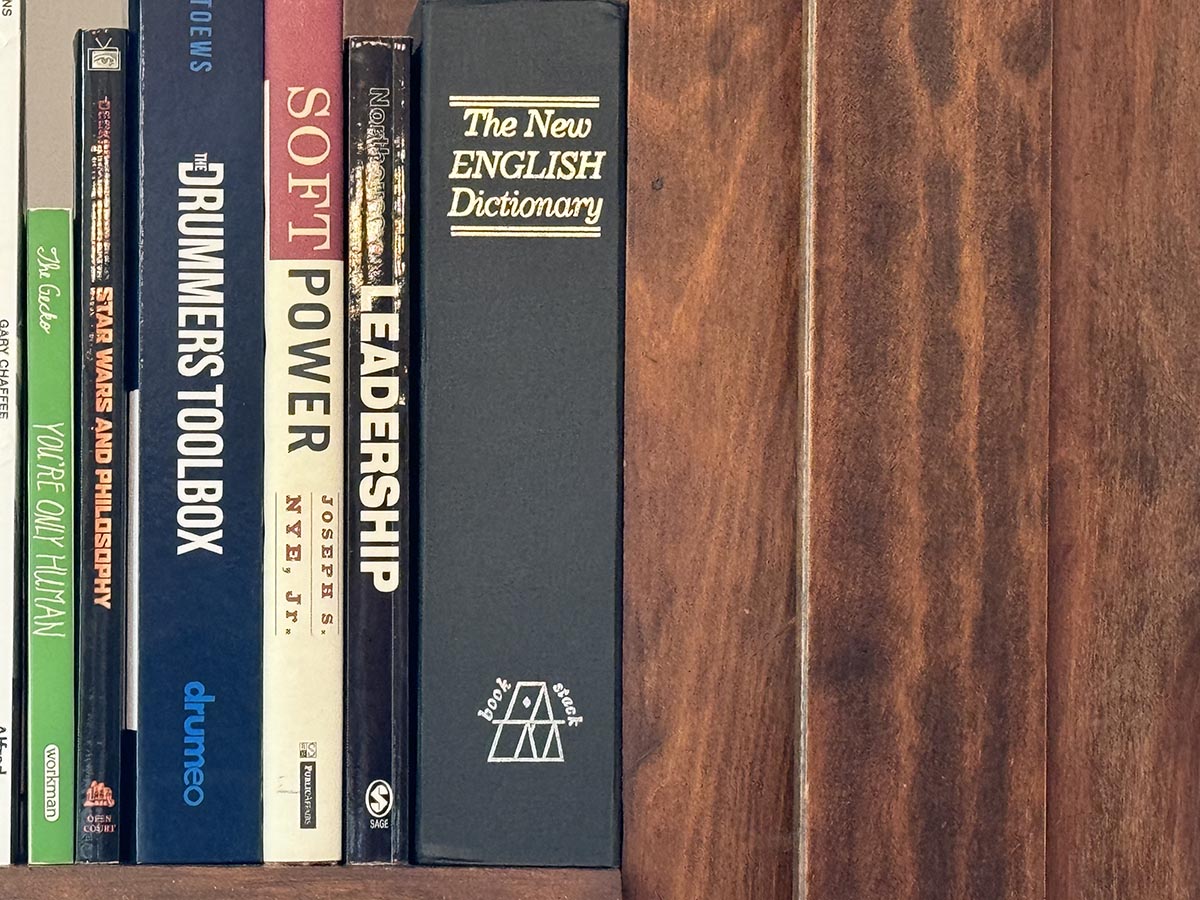
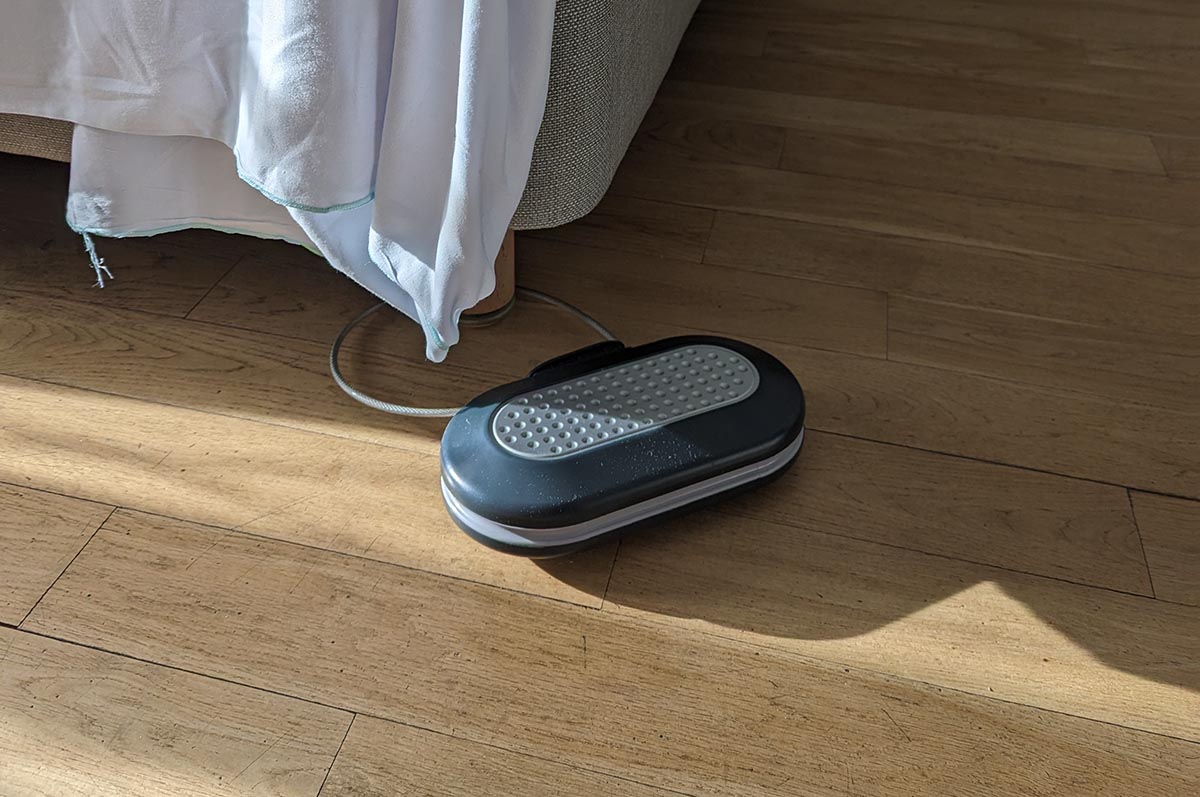
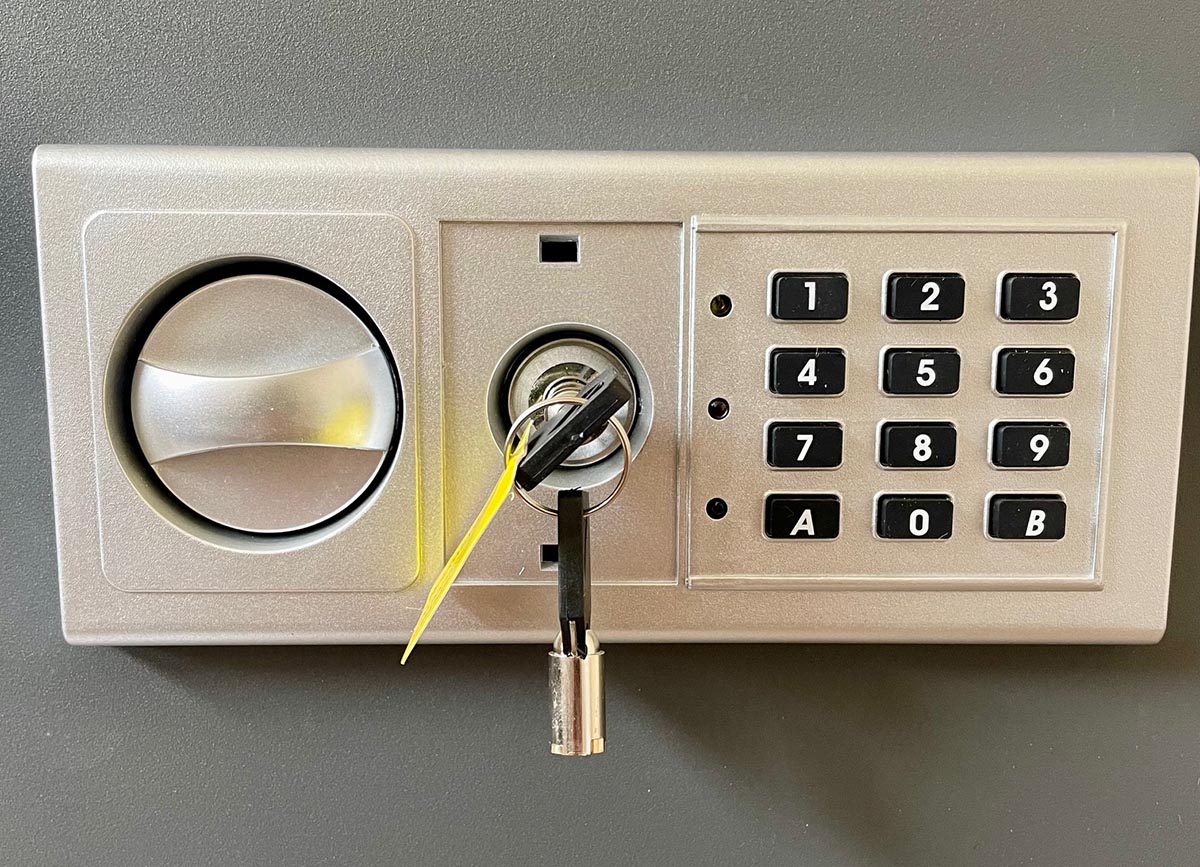
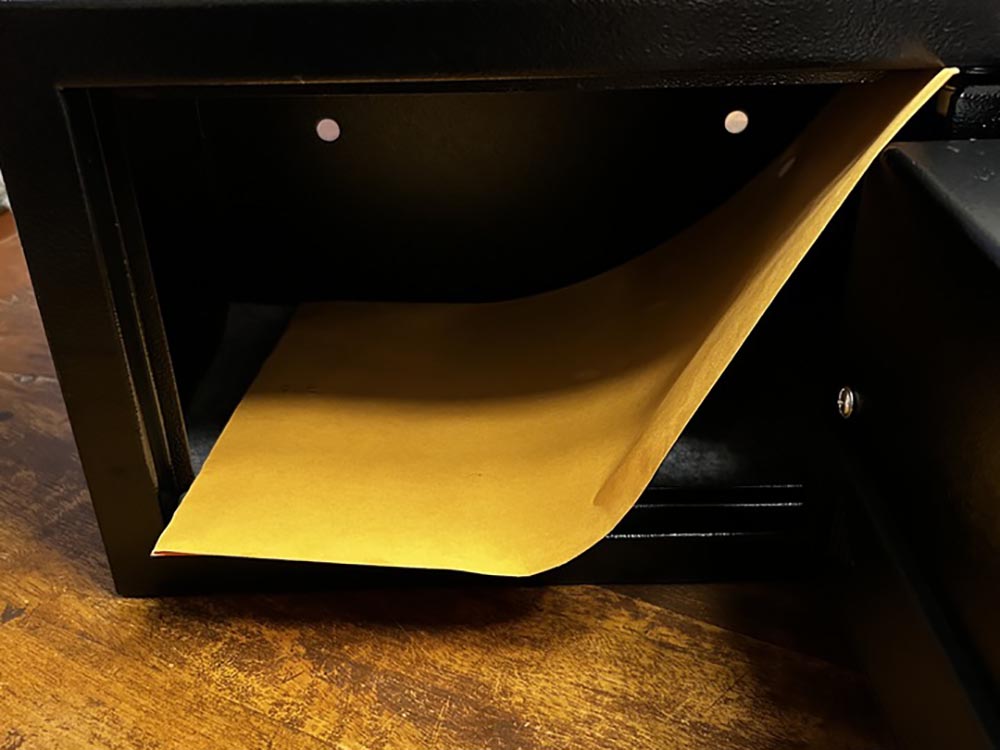
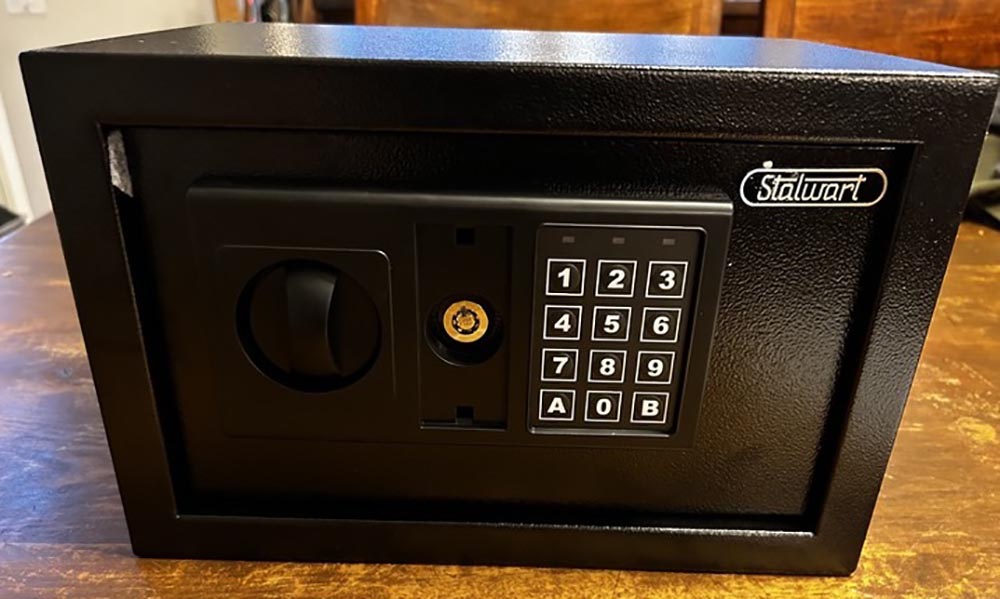
What to Consider When Choosing a Home Safe
Secure safes hold some of the most valuable items in your home, so it’s important to find a reliable option. When choosing the best home safe for your home, consider its protective capabilities, size, weight, lock type, and any additional convenience or security features that are important to you.
Types of Home Safes
Before you choose a secure storage space for your valuables, consider the type of safe that will work best for you and learn about the features offered with each type.
Fire-Resistant Safes
Heavy insulation in fire safes protects their contents from heat, smoke, and sometimes water. Often small and portable, many fire-resistant safes open with a simple key or combination. Fire safes are rated by the global safety consulting and certification company UL and other agencies based on the length of time the interior of the safe can remain below a certain temperature when the exterior has reached fire-level temperatures.
UL-classified fire-resistant safes are built to withstand peak temperatures ranging from 1,150 degrees Fahrenheit to 1,850 degrees Fahrenheit for up to 2 hours. They should be stored on concrete, such as a garage or basement floor, and away from flammable materials.
Burglary Safes
The most secure residential safes are tough enough to keep both thieves and fire out. A burglary safe, constructed with thick, insulated walls; a heavy door; and other safety features, may provide both theft protection and fire resistance. Some also include water-resistant features. Burglary safes are available in two main forms:
- Stand-alone safes that don’t require installation into a wall or floor recess. They come in a variety of sizes, from small home safes to large standing units. They tend to have a heavier and sturdier build, and their thicker walls provide added protection against theft and fire.
- Wall safes are meant to be installed into a recess in the wall, usually between two wall studs. Similarly, floor safes sit in a recess in the floor. You can conceal these safes behind a painting or a cabinet or under a rug to add another layer of security. However, they aren’t very large and tend to have thinner walls and doors.
Gun Safes
A gun safe is a must-have for safe gun storage at home. A sturdy lock keeps contents from curious little fingers. Consider the safe’s intended use when making your pick, since some gun-specific safes place less focus on theft, fire, or water protection.
For keeping guns safely out of reach of children, a simple locked gun safe is a suitable choice. If burglary is your main concern, look for a gun safe with an anti-pry design intended to prevent theft.
Gun safes come in a range of sizes, from bedside handgun boxes to large rifle safes. Keep in mind that it’s always best to keep the safe out of reach of young children. Also, consider the lock type. A safe with a combination or biometric lock means no keys to hide (or lose), which also means no keys for curious kids to stumble across.
Jewelry Safes
Jewelry is easy fodder for burglars. Keeping jewelry tucked away in a home safe adds an extra layer of security.
While most jewelry fits in any home safe, certain features help protect precious pieces while they’re in storage. Protective shelving, such as soft carpeted or felted shelves, helps prevent scratches and dings on expensive jewelry. Hanging hooks prevent tangles in chains and other baubles.
While less secure, a locked jewelry wall armoire is one alternative. These units mount to the wall and include plenty of organizers and hanging spaces to keep jewelry beautifully displayed inside. To secure jewelry, locking armoires may deter curious children or opportunistic burglars.
Security Rating
Home safe ratings take into consideration both the safe’s construction and its ability to thwart forced-entry attempts. UL rates some safes, but not all safes on the market come with ratings.
Generally, the heavier and thicker the safe’s walls and doors, the higher the rating. The higher the rating, the higher the price for the safe. Common burglary ratings for safes without alarms are as follows:
- B-rated: Recommended for storing $5,000 or less in valuables
- B/C-rated: For up to $10,000 in content value
- RSC: For up to $15,000 in content value
- C-rated: For up to $25,000 in content value
- TL-15: Recommended for storing up to $100,000 in valuables; can withstand a 15-minute attack with common tools and devices
Size and Weight
Home safes range from small, portable options to large, freestanding units capable of being bolted down. The ideal home safe should offer enough room for the items you plan to store plus a bit of wiggle room for valuables you may acquire in the future. Stack the items you plan to store and measure the stack’s dimensions to determine the appropriate size for your home safe.
Home safes generally measure around 0.5 to 1.3 cubic feet, with smaller and larger options available. An average-size 1.2-cubic-foot safe will probably weigh around 100 pounds. Although they may be tougher to set up and move around, the heavy weight of a permanent safe adds an extra layer of security against theft.
Portability
A portable home safe can be a useful accessory for renters or frequent travelers. These smaller safes are usually made to hold a few important items like passports, cash, important documents, and other small objects. A good portable safe will be reasonably lightweight, usually under 30 pounds, for easier transport.
Portable home safes have one downside, which is that they’re easier to steal. But these safes still provide a layer of protection against theft, plus many users have them for fire and water protection. If you don’t plan on moving the safe anytime soon, though, you may want to look for a more secure option. A heavy-duty safe that bolts down will be harder for robbers to take advantage of and, therefore, a better option to protect against theft.
Lock Type
Home security safes may require a key, a combination, an electronic keypad code, or biometric data to access their contents.
Classic key or combination locks don’t require a power source. Just insert the key or enter the combination to unlock the safe. As with padlocks, one downside of a key lock is the risk of losing the key. If you choose a safe with a combination lock, look for an option with a backup key to prevent locking yourself out.
The next step up in complexity is a home safe with an electronic keypad, for which users enter their access code into the keypad rather than turning a combination dial. Lastly, biometric locks have an advanced fingerprint sensor that reads your fingerprint and unlocks if it matches a print in the fingerprint library. Electronic keypads and biometric scanners need a power source, such as batteries or an AC outlet.
Waterproofing
Water-resistant safes protect valuables from flooding, leaks, and other costly water damage. Consider whether waterproofing is necessary for your needs depending on your location and where the safe is stored. Water exposure may be more of a concern in flood-prone areas or for a safe stored in a basement.
Some safes protect against minor water exposure, like splashes or shallow water, while others can be completely submerged for a specified length of time. For submersion protection, consider a safe with an ETL Waterproof Verification. The ETL gives its seal of approval to safes that can withstand a certain level of water exposure for a specified time frame.
Additional Features
Home safes may include a range of extra features for added security, convenience, and accessibility, including bolting hardware, adjustable shelves, protective carpet, and lighting.
- Bolting hardware helps secure a stand-alone safe to the ground. A bolted safe is extremely difficult for burglars to remove, adding an extra layer of security against theft.
- Adjustable shelves and removable shelves allow you to organize the space inside the safe.
- Protective carpet guards valuables from scratches. Some safes include protective carpeting along the interior shelves or walls. This added feature gives items like jewelry a soft place to land.
- Lighting helps you see the items inside the safe, even in dim conditions. Home safes may feature interior lighting or keypad lighting. Some electronic keypads include backlighting to make it easier to enter the code.
- Alarms add an extra layer of security by alerting anyone nearby of unauthorized safe access.
- Humidity and temperature controls help protect sensitive documents and items from moisture and temperature fluctuations.
FAQs
A home safe is one part of a robust home security plan to keep you and your valuables safe. These relatively inexpensive units can give you peace of mind against theft, fire, and water damage. Read on for frequently asked questions about choosing and using your new home safe.
The top home safes are made of heavy steel, a half-inch-thick door, and quarter-inch-thick walls.
The SentrySafe SFW123GDC waterproof and fireproof home safe is one of the most secure options, providing excellent protection against theft, fire, and water.
Choose a spot that is as hidden as possible to prevent theft but that is also accessible enough so you can grab items when you need them. Try to avoid placing the safe in an area that is at high risk for humid conditions or flooding.
Most safes include a digital keypad or biometric technology for opening and a backup key. If you can’t get into your safe, start by contacting the safe manufacturer—the company should have a process in place so you can regain access to your safe.
Yes, a home safe can be breached with enough time and effort. To deter burglars as much as possible, look for a quality safe that is difficult to remove from the home or that will take a long time to break into.
If a home safe is stolen, it is treated like other stolen property and may be difficult to recover. File a police report and contact your home insurance broker to assess next steps.
Meet the Tester
Michelle Larson has been a writer and editor for more than 10 years in the fields of health, business, and the home. Because she’d rather spend a little more up front than buy a tool or appliance twice, she strongly believes in the power of research and reviews for finding quality items that are meant to last.
Additional testing performed by Kathleen Corlett, Austin Fracchia, Paul Rankin, Glenda Taylor, Daryna Tobey, and Mark Wolfe. The Bob Vila test team is made up of contractors, remodelers, home design enthusiasts, and freelancers from across the nation. Each member is dedicated to delivering high-quality product information to our readers so they can shop with confidence, knowing the products they purchase have been fully tested and vetted.
Additional research provided by Michelle Ullman and Jasmine Harding.


